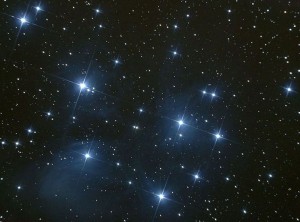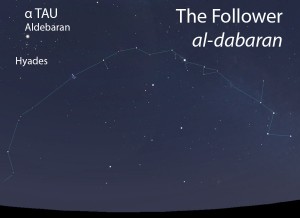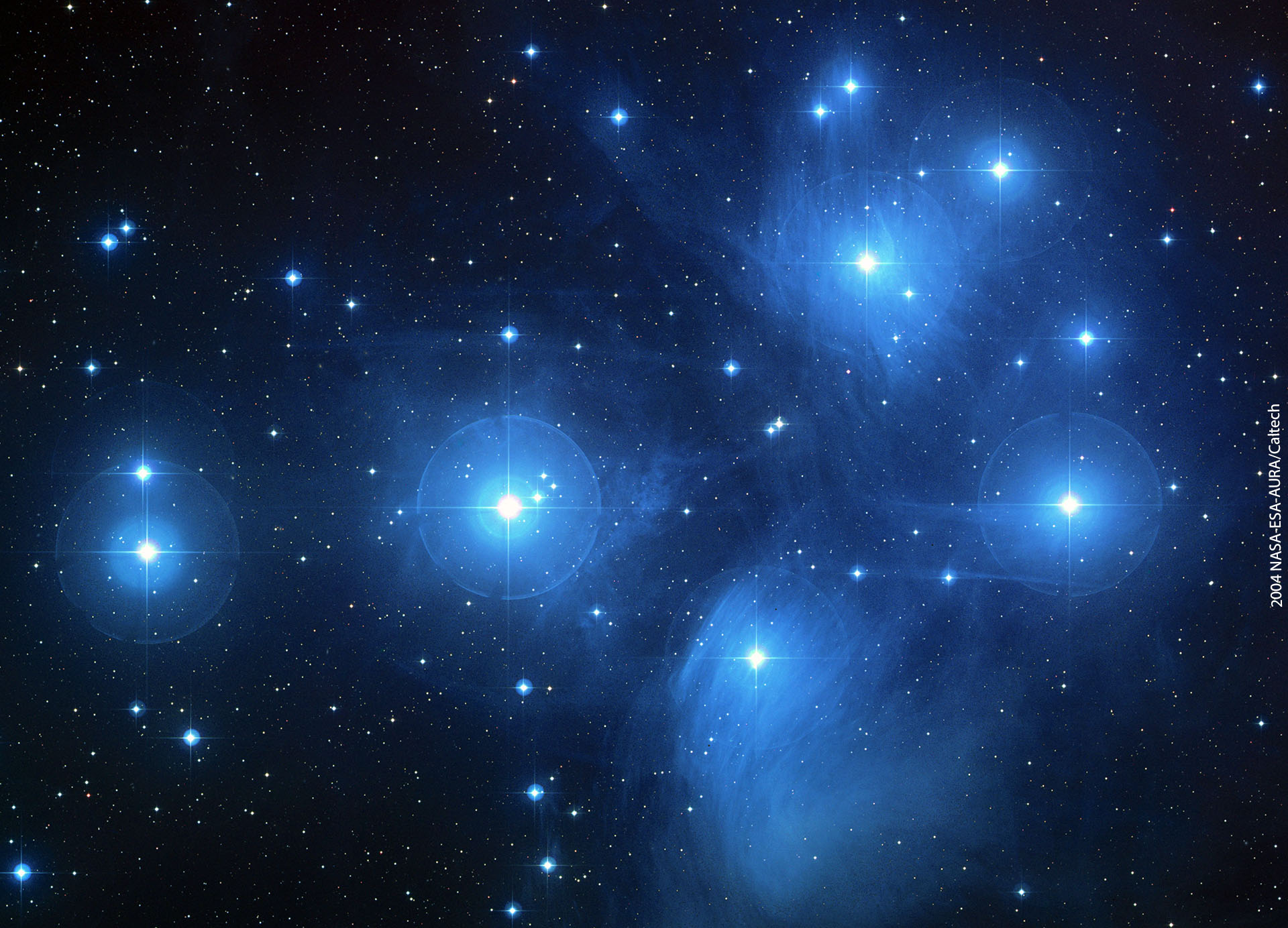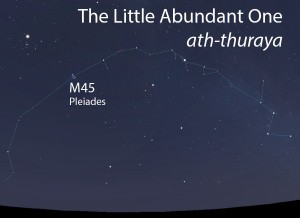Feature image credit: NASA-ESA-AURA/Caltech
The heavy marking rains of autumn (al-wasmi) conclude with the pre-dawn setting of Thuraya, a celestial object whose brilliance and beauty are renowned to this day in cultures around the world. This asterism is a bright cluster of stars that is easily visible to the unaided eye and known to us today as the Pleiades. An unmistakeable asterism of great significance, Thuraya was often called simply “the Asterism” (an-najm).
إذا ما الثريا في السماء تعرضت تعرض أثناء الوشاح المفصل
When Thuraya inclined obliquely in the sky
like the variegated gems of a beaded sash,
whose folds drape from shoulder to opposing waist.Imru’ al-Qays,
6th century C.E.

Thuraya (the Pleiades) as it appears from mid-northern latitudes when setting. Image by Lukáš Kalista, rotated and cropped. CC BY-SA 3.0 via Wikimedia Commons.
The verse above is from a pre-Islamic collection of poetry called the Mu’alaqat. The description of the appearance of Thuraya is not just vivid; it is also literal, for it describes the orientation of the asterism as it prepares to set, in this case, at the end of the night. Classical Arabic poetry is full of these uses of stars as celestial clocks that set the timeframe for a piece of poetry.
The name “Thuraya” is very old. Grammatically, the word is a diminutive, and so its meaning would be akin to “the Little Abundant One”, which grammarians tend to relate to its many stars. Additionally, this meaning may refer to the abundance of rain that falls during its rain period (see below). This possibility is strengthened by the existence of very a similar sounding word that indicates moisture. The feminine diminutive form of Thuraya gives the word a sense of endearment, like the English “dearie” or “horsey”. In legend, Thuraya is anthropomorphized as a woman.
How to observe Thuraya

The Hands of Thuraya (aydi ath-thuraya) as they appear setting in the west about 45 minutes before sunrise in mid-November. Sky simulations made with Stellarium.
The proper time to observe a star’s morning setting (or rising) is called ghalas in Arabic, at time when the darkness of night mixes with the white and red light of dawn in the tracts of the horizon (How to Observe). Look to the western horizon about 45 minutes before your local sunrise (times available at timeanddate.com). Thuraya itself will appear as a tight cluster of moderately bright stars located at the Tail of the Lamb (alyat al-hamal). The Hands of Thuraya begin to set about a month before Thuraya itself does, shortly after the Lamb begins to set.
ألا طرقت مي هيوما بذكرها وأيدي الثريا جنخ في المغارب
Won’t Mayya come in the night
to one amorously mystified by her mention,
when the Hands of Thuraya
reach for the western places of sunset?Dhu ar-Rumma,
735 C.E.
As an anthropomorphized figure, the Hands of Thuraya (aydi ath-thuraya) extend across a large amount of sky. Thuraya has two hands, the Amputated Hand (al-kaf al-jadhma’), which extends down to the left (south in the sky) of Thuraya, and the Henna-Dyed Hand (al-kaf al-khadib), which extends a longer distance across the sky in the opposite direction (north).
Thuraya as a rain star
For a brief description of the rain stars, please see the Celestial Complexes section on the About page.
The pre-dawn setting of Thuraya marks the close of the wasmi “marking” rainy season, which began with the setting of the latter half of the Well Bucket in our first post. The calendars of Qushayr and Qays indicate that approximately 15 nights should pass between each of the three asterisms of al-wasmi. Each asterism requires some time for all of its stars to set, except for Thuraya. Therefore, about 15 nights should pass from the setting of the second star of the Rear Two Crossbars of the Bucket (al-‘arquwatan al-mu’akharatan min ad-dalw) until the setting of the first star of the Signs (ash-sharatan). Likewise, 15 nights should pass between the setting of the last star of the Signs until the setting of Thuraya.
Thuraya and its Follower as lunar stations
For a brief description of the lunar stations, please see the Celestial Complexes section on the About page.

The Follower of Thuraya (ad-dabaran) as it appears in the west about 45 minutes before sunrise in early November.
Both the star cluster of Thuraya and the bright red star that is its Follower (ad-dabaran) are included within the calendar of lunar stations. In the account of Qutrub (died 821 CE), Thuraya is referred to as the Asterism (an-najm) and appears as the fifth lunar station. The Follower is the sixth lunar station. As we’ve seen before, this order shifts up two spots by the time of Ibn Qutayba (died 889), when these two lunar stations appear as the third and fourth, respectively.
The 8th century CE poet Dhu ar-Rumma famously describes the Follower of Thuraya as a red-turbaned camel herder. With a crowd of camels in front of him (the stars that make up the Hyades star cluster), the camel herder drives them to the watering hole. He forever follows in Thuraya‘s footsteps, neither falling behind nor overtaking her.
The stars of Thuraya amidst the Greek constellations
The stars of Thuraya remain well-known in Arabic-speaking lands today, but this name did not survive among European astronomical works, and so today we know this star cluster as the Pleiades, a long-used Greek name. Surprisingly, even though the Hands of Thuraya were chopped up into the Greek constellations of Cassiopeia, Perseus, Taurus and Cetus, several of its star names remain intact.
In the modern-day constellation of Cetus, the star gamma (γ) is known as Kaffaljidhmah, a rather close transliteration of the Arabic, al-kaf al-jadhma’, the Amputated Hand. Similarly, the end star of the other Hand, now located in modern-day Cassiopeia, is recognized officially as Caph, from al-kaf al-khadib, the Henna-Dyed Hand.
In Perseus, three of the many well-articulated points of the Henna-Dyed Hand also remain. The brightest star of Perseus (α) is known alternately as Mirfak (from al-mirfaq, the Elbow) or Algenib, which comes from an Arabic description of its location in the Greek figure of Perseus. Moving up to the shoulder area, both Menkib (ξ, from al-mankib, the Shoulder) and Atik (ο, from al-‘atiq, the Shoulder Blade) remain in their correct positions and have names that have been essentially unchanged from the Arabic.
Lastly, after fourteen or more centuries of cultural change, the Arabic name of the Follower, “ad-dabaran“, is nearly perfectly preserved as Aldebaran in modern-day Taurus. The red-turbaned camel herder continues to follow Thuraya across the night sky.
What’s next?
In the next post, we will meet another famous female figure in the night sky, one whose story may go back tens of thousands of years.
In the meantime, I’d love to hear from you! Please leave a comment below, and tell me about your observations of these ancient asterisms. Be sure to include your city and state/country so we can see how the timings vary by location.
Star Catalog Entries for this Celestial Complex
The Hands of Thuraya Complex (aydi ath-thuraya, أيدي الثريا)
Thuraya/The Little Abundant One (ath-thuraya, الثريا), known as the Asterism (an-najm, النجم)
The Amputated Hand (al-kaf al-jadhma’, الكف الجذماء)
The Henna-Dyed Hand (al-kaf al-khadib, الكف الخضيب)
The Tattoo of the Wrist (washm al-mi’sam, وشم المعصم)
The Forearm of Thuraya (dhira’ ath-thuraya, ذراع الثريا)
The Pit of the Elbow (al-ma’bid, المأبد)
The Elbow (al-mirfaq, المرفق)
The Tip of the Elbow (ibrat al-mirfaq, إبرة المرفق)
The Upper Arm (al-‘adud, العضد)
The Shoulder (al-mankib, المنكب)
The Shoulder Blade (al-‘atiq, العاتق)
The Follower (ad-dabaran, الدبران)
Click here to go to the full star catalog (a work in progress).


